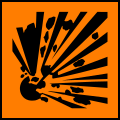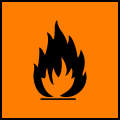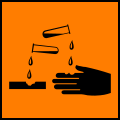European hazard symbols
Pictograms for labelling chemicals in the European Union From Wikipedia, the free encyclopedia
European hazard symbols for chemicals are pictograms defined by the European Union for labelling chemical packaging (for storage and workplace) and containers (for transportation). They are standardised currently by the CLP/GHS classification.[1]
This article needs additional citations for verification. (July 2018) |
GHS hazard pictograms
- The European Union CLP Regulation (for "Classification, Labelling and Packaging") was introduced as EC Regulation 1272/2008. It is based on the GHS system, to secure for "physical, health and environment hazards".[2][1][3]

- The European Agreement concerning the International Carriage of Dangerous Goods by Road (ADR) fixed harmonised pictograms for transportation. Vehicles carrying dangerous goods have to be fitted with orange signs, where the lower number identifies the substance, while the upper number is a key for the threat it may pose.
Chemical warning signage
Directive 92/58/EEC provides several safety signs for identifying dangerous materials and areas where they are handled and stored.[4]
- Directive 92/58/EEC Warning Signage
- Flammable material
- Explosive material
- Toxic material
- Corrosive material
- Oxidant material
- Harmful or irritant material
(Withdrawn 2014)[5]
Former hazard pictograms (1967–2017)
Summarize
Perspective
The previous hazard symbols for chemicals, were introduced in the Directive Directive 67/548/EEC, in 1967, and required to be adopted no later than 1 January 1970.[6] The symbols were also included as a part of Directive 1999/45/EC.[7] The symbols were replaced from 1 December 2010 to 1 June 2017, via a gradual phaseout.[1] After 1 June 2017, Directive 67/548/EEC symbols were no longer allowed to be used.[1]
From 1967 to 2017, these symbols were used for labeling containers and piping systems containing dangerous substances/mixtures. These symbols could also be used to identify areas where dangerous substances/mixtures were being stored in large quantities, as an alternative to the yellow triangular Directive 92/58/EEC warning signage.[4]
| Hazard pictogram & mention, code | Substances examples |
|---|---|
 Explosive (E) Explosive (E) | TNT, acetone peroxide, nitroglycerin, picric acid |
 Extremely Flammable (F+) Extremely Flammable (F+) | Hydrogen, acetylene, propane, butane, diethyl ether, carbon disulfide, acetaldehyde |
 Highly Flammable (F) Highly Flammable (F) | Ethanol, acetone, gasoline, hexamine, methanol |
 Oxidizing (O) Oxidizing (O) | Oxygen, potassium nitrate, hydrogen peroxide, nitric acid, potassium permanganate |
 Toxic (T) Toxic (T) | Sulfuric acid, TNT, Nitroglycerin, carbon disulfide, methanol, ammonia, formaldehyde |
 Very toxic (T+) Very toxic (T+) | Prussic acid, nicotine, carbon monoxide, white phosphorus |
 Harmful (Xn)[a] Harmful (Xn)[a] | Hexamine, butane, naphtha, acetaldehyde |
 Irritant (Xi) Irritant (Xi) | Sodium hypochlorite, acetone, ethanol |
 Corrosive (C) Corrosive (C) | Sulfuric acid, Nitric acid, sodium hydroxide, ammonia, White phosphorus |
 Dangerous for the environment (N) Dangerous for the environment (N) | Sulfuric acid, turpentine, lead, mercury, Crude oil |
Notes
References
External links
Wikiwand - on
Seamless Wikipedia browsing. On steroids.





